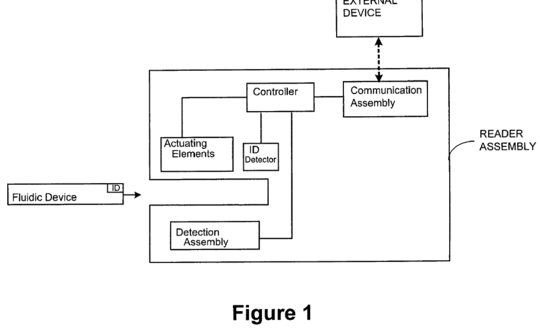Theranos Patent for Point of Care System
May 01 2019
The story of Elizabeth Holmes and Theranos is well known. The company claimed to have technology for testing blood that required only about 1/100 to 1/1,000 of the blood compared to traditional blood tests, while costing far less. https://www.hematology.org/Thehematologist/Op-Ed/6540.aspx, https://www.newyorker.com/magazine/2014/12/15/blood-simpler. Theranos claimed to have a point of care system named 'Edison', that was capable of running such tests, however, it was later discovered that the machine did not work. See https://www.refinery29.com/en-us/2019/03/224904/theranos-edison-machine-blood-test-technology-explained.
Theranos has numerous patents directed at different medical technologies. In US patent 7635594 B2, a Theranos patent describes a point of care system (note the first named inventor, Elizabeth A. Holmes). A point of care system is like a blood test lab that one can have at her bedside. With such a machine, one can potentially administer her own blood tests virtually anywhere.
In the Theranos patent US7635594, the point of care system communicates with the internet to test a sample of bodily fluid. More specifically, what is claimed here appears to be a device that gets instructions from the internet, to run tests that will detect the presence of an analyte in a fluid sample (e.g., blood), then communicate the results back through the internet. Those results are then compared to medical data. Based on the comparison, the device can run an additional test, targeted based on findings from the comparison. In other words, using data and test protocols from the internet, the device can intelligently generate additional tests to detect things of interest in the blood.
Interestingly, one of the dependent claims of the patent states that the sample can be less than 500 ul, which is about 10 drops of blood. In another section, the patent states that "The volume of bodily fluid to be used with a fluidic device of the present invention is generally less than about 500 microliters, typically between about 1 to 100 microliters. Where desired, a sample of 1 to 50 microliters or 1 to 10 microliters [which is less than a drop of blood] can be used for detecting an analyte using the subject fluidic device." Thus, this Theranos patent, which was filed way back in 2006, features Theranos' claim to fame, which is to be able to perform blood tests with a drop of blood. Other Theranos patents also include this feature.
Also noteworthy, although Theranos has shut down since 2018, 5 new patents have already been granted to Theranos in 2019. https://www.cbinsights.com/research/theranos-patents-2019/